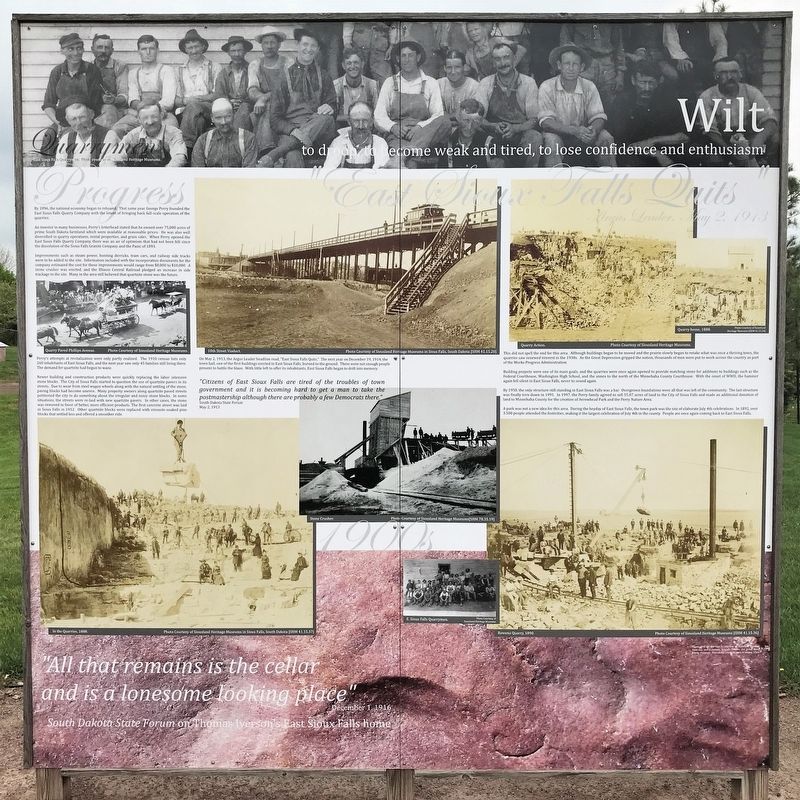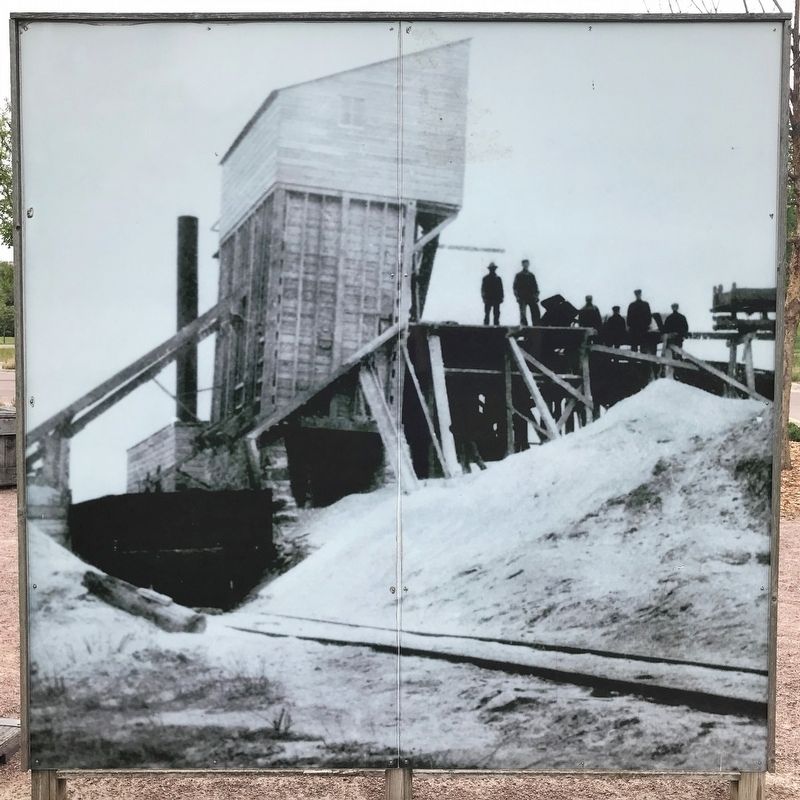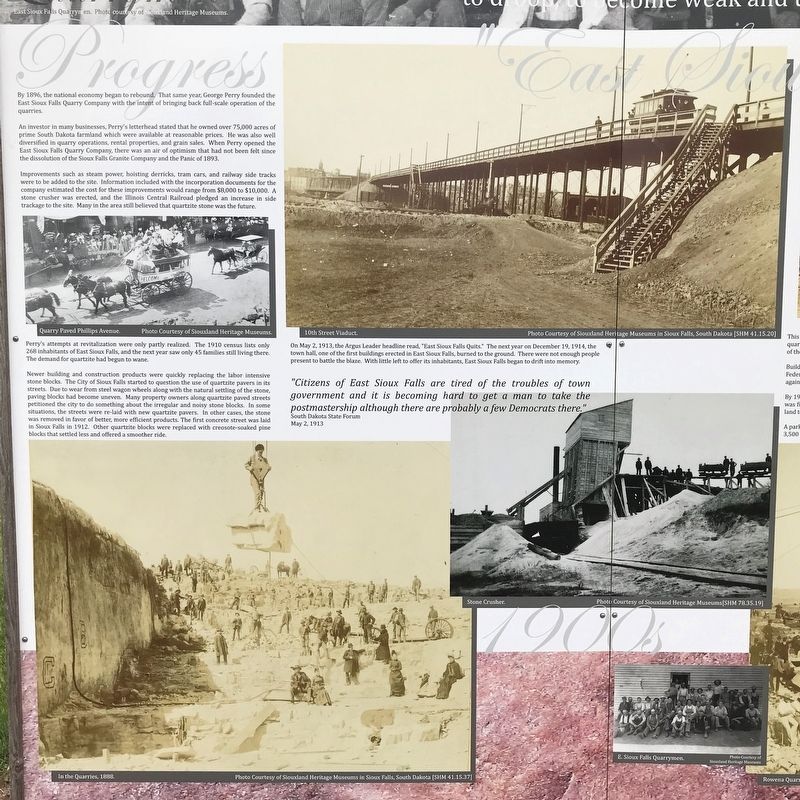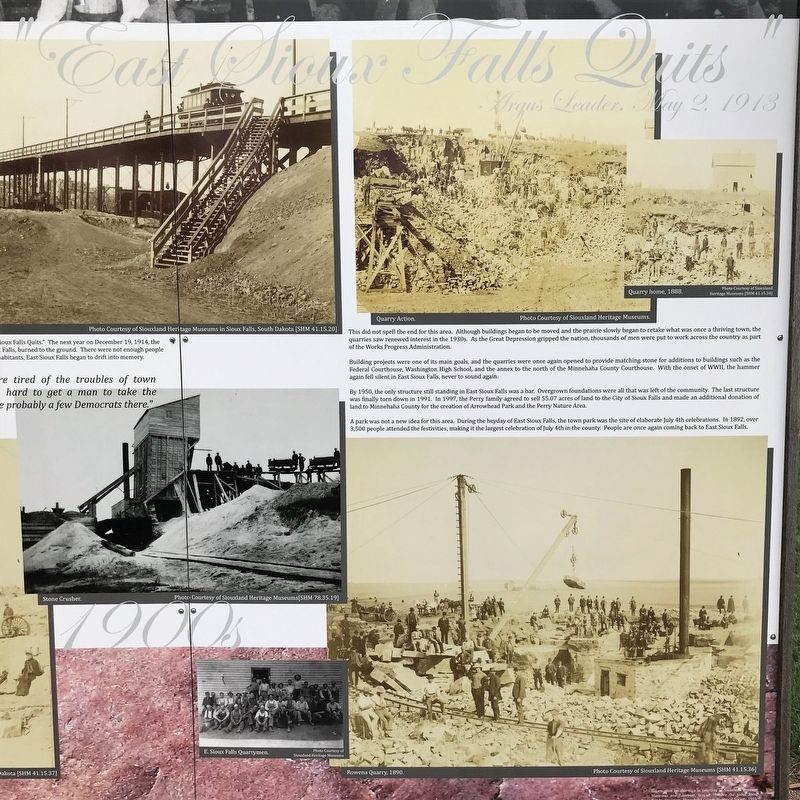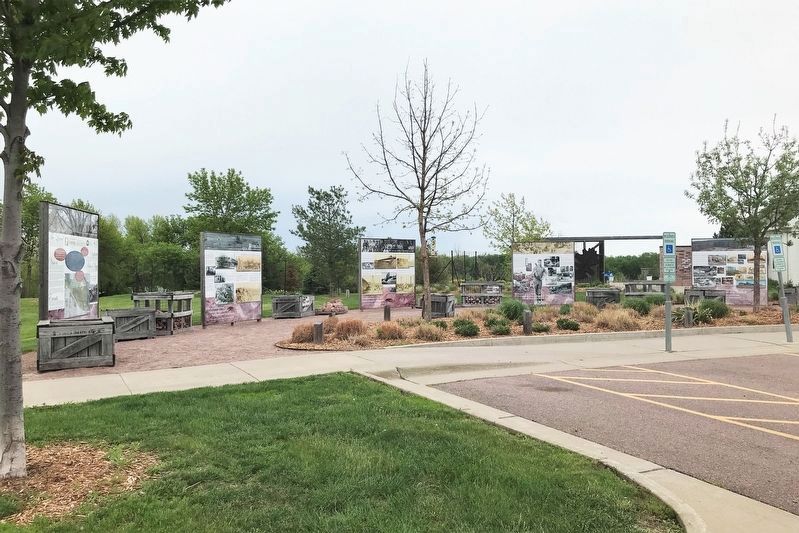Sioux Falls in Minnehaha County, South Dakota — The American Midwest (Upper Plains)
Wilt
header:
Quarrymen
East Sioux Falls Quarrymen. Photo courtesy of Siouxland Heritage Museums.
Progress
By 1896, the national economy began to rebound. That same year, George Perry founded the East Sioux Falls Quarry Company with the intent of bringing back full-scale operation of the quarries.
An investor in many businesses, Perry's letterhead stated that he owned over 75,000 acres of prime South Dakota farmland which were available at reasonable prices. He was also well diversified in quarry operations, rental properties, and grain sales. When Perry opened the East Sioux Falls Quarry Company, there was an air of optimism that had not been felt since the dissolution of the Sioux Falls Granite Company and the Panic of 1893.
Improvements such as steam power, hoisting derricks, tram cars, and railway side tracks were to be added to the site. Information included with the incorporation documents for the company estimated the cost for these improvements would range from $8,000 to $10,000. A stone crusher was erected, and the Illinois Central Railroad pledged an increase in side trackage to the site. Many in the area still believed that quartzite stone was the future.
photo:
Quarry Paved Phillips Avenue.
Photo Courtesy of Siouxland Heritage Museums.
Perry's attempts at revitalization were only partly realized. The 1910 census lists only 268 inhabitants of East Sioux Falls, and the next year saw only 45 families still living there. The demand for quartzite had begun to wane.
Newer building and construction products were quickly replacing the labor intensive stone blocks. The City of Sioux Falls started to question the use of quartzite pavers in its streets. Due to wear from steel wagon wheels along with the natural settling of the stone, paving blocks had become uneven. Many property owners along quartzite paved streets petitioned the city to do something about the irregular and noisy stone blocks. In some situations, the streets were re-laid with new quartzite pavers. In other cases, the stone was removed in favor of better, more efficient products. The first concrete street was laid in Sioux Falls in 1912. Other quartzite blocks were replaced with creosote-soaked pine blocks that settled less and offered a smoother ride.
photo:
10th Street Viaduct.
Photo Courtesy of Siouxland Heritage Museums in Sioux Falls, South Dakota [SHM 41.15.20]
On May 2, 1913, the Argus Leader headline read, "East Sioux Falls Quits." The next year on December 19, 1914, the town hall, one of the first buildings erected in East Sioux Falls, burned to the ground. There were not enough people present to battle the blaze. With little left to offer its inhabitants, East Sioux Falls began to drift into memory.
"Citizens of East Sioux Falls are tired of the troubles of town government and it is becoming hard to get a man to take the postmastership although there are probably a few Democrats there."
South Dakota State Forum
May 2, 1913
"East Sioux Falls Quits"
Argus Leader. May 2, 1913
photos:
Quarry Action.
Photo Courtesy of Siouxland Heritage Museums.
Quarry home, 1888.
Photo Courtesy of Siouxland Heritage Museums [SHM 41.15.34]
This did not spell the end for this area. Although buildings began to be moved and the prairie slowly began to retake what was once a thriving town, the quarries saw renewed interest in the 1930s. As the Great Depression gripped the nation, thousands of men were put to work across the country as part of the Works Progress Administration.
Building projects were one of its main goals, and the quarries were once again opened to provide matching stone for additions to buildings such as the Federal Courthouse, Washington High School, and the annex to the north of the Minnehaha County Courthouse. With the onset of WWII, the hammer again fell silent in East Sioux Falls, never to sound again.
By 1950, the only structure still standing in East Sioux Falls was a bar. Overgrown foundations were all that was left of the community. The last structure was finally torn down in 1991. In 1997, the Perry family agreed to sell 55.07 acres of land to the City of Sioux Falls and made an additional donation of land to Minnehaha County for the creation of Arrowhead Park and the Perry Nature Area.
A park was not a new idea for this area. During the heyday of East Sioux Falls, the town park was the site of elaborate July 4th celebrations. In 1892, over 3,500 people attended the festivities, making it the largest celebration of July 4th in the county. People are once again coming back to East Sioux Falls.
1900s
photos:
In the Quarries, 1888.
Photo Courtesy of Siouxland Heritage Museums in Sioux Falls, South Dakota [SHM 41.15.37]
Stone Crusher.
Photo Courtesy of Siouxland Heritage Museums[SHM 78.35.19]
E. Sioux Falls Quarrymen.
Photo Courtesy of Siouxland Heritage Museums
Rowena Quarry, 1890.
Photo Courtesy of Siouxland Heritage Museums [SHM 41.15.36]
"All that remains is the cellar and is a lonesome looking place"
December 1, 1916
South Dakota State Forum on Thomas Iverson's East Sioux Falls home
Information on this sign is courtesy of Siouxland Heritage Museums and Fanebust, Wayne. Where the Sioux River Bends. Freeman: Minnehaha County Historical Society, 1985.
Topics. This historical marker is listed in these topic lists: Industry & Commerce • Settlements & Settlers. A significant historical year for this entry is 1896.
Location. 43° 31.634′ N, 96° 36.377′ W. Marker is in Sioux Falls, South Dakota, in Minnehaha County. Marker is on South Perry Place, 0.1 miles north of State Highway 42, on the right when traveling north. Located at the Mary Jo Wegner Arboretum & East Sioux Falls Historic Site. Touch for map. Marker is at or near this postal address: 1900 S Perry Pl, Sioux Falls SD 57110, United States of America. Touch for directions.
Other nearby markers. At least 8 other markers are within walking distance of this marker. bud (here, next to this marker); Flourish (here, next to this marker); Sprout (here, next to this marker); Seed (a few steps from this marker); Disperse (a few steps from this marker); fruit (a few steps from this marker); vegetate (within shouting distance of this marker); unearth (within shouting distance of this marker). Touch for a list and map of all markers in Sioux Falls.
Credits. This page was last revised on June 2, 2022. It was originally submitted on June 1, 2022. This page has been viewed 85 times since then and 7 times this year. Photos: 1, 2, 3, 4, 5. submitted on June 1, 2022.
